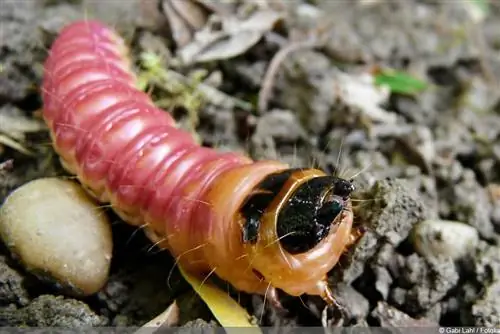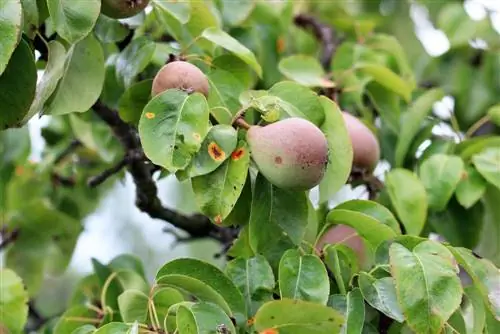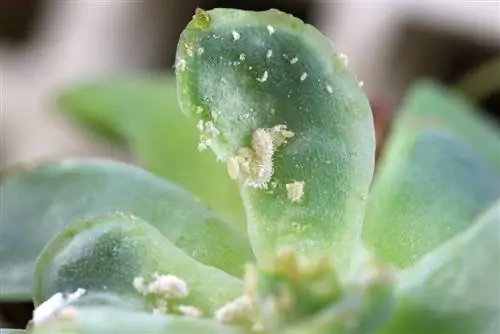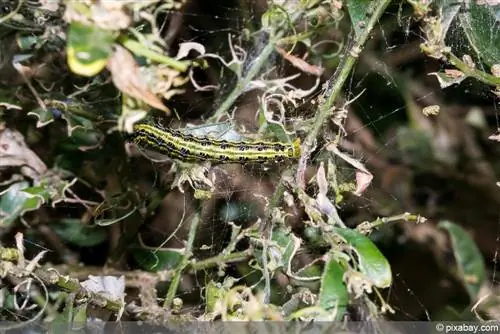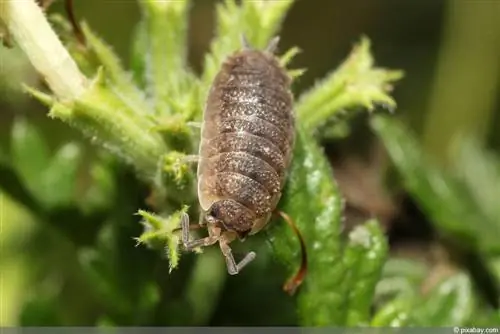- Author admin [email protected].
- Public 2023-12-17 03:39.
- Last modified 2025-01-24 12:45.
Small willow borer caterpillars compete against a large tree and still win the duel. Time is her secret ally and of course her hard work. It may take years, but at some point every tree will give up. Too many holes run through the trunk and weaken its vitality. Speed is required to block the caterpillars' way into the deepest interior of the fruit trees.
Profile
- Willow borer is a species of butterfly (moth)
- comes from the wood borer family
- Cossus cossus is its scientific name
- only affects deciduous trees
- Willows are preferred host plants, but so are apple and pear trees
- the butterfly is hairy, the wings are mottled grey-brown
- Wingspan: up to 8 cm for males, 10 cm for females
- twilight and nocturnal
- Larvae reach a length of up to 10 cm
- strong red color, black neck plate
Toxicity
The caterpillar is not poisonous in itself. But she has powerful cutting tools and knows how to defend herself. That hurts. Direct contact with it can also cause skin irritation.
malicious image
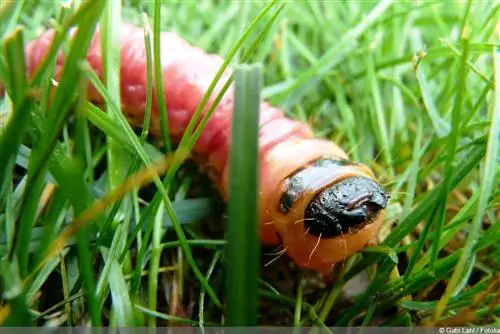
The butterfly is well camouflaged in color on the tree bark, the caterpillars are buried deep in the tree trunk. How can an infestation be identified clearly and, above all, in a timely manner? It is the traces left behind that provide clear evidence of the presence of the willow borer.
- Bark has large round oval drill holes
- there is reddish drill dust in the openings
- the caterpillar droppings are transported out of the borehole
- he can therefore also be discovered at the hole opening
- large areas of brittle bark can be removed
- the tree gives off a strong smell of vinegar
The typical vinegar smell is an invitation to other butterflies. They lay their eggs, which gives a strong boost to the progression of the infestation. The damage caused can now be clearly seen on the tree.
- withered branches
- withering leaves
In the final stage of the infestation, the tree finally dies.
Tip:
A heavily perforated tree increasingly loses stability and can snap “unexpectedly”. The falling parts of trees pose a danger. Precautionary felling is advisable if the infestation is known and can no longer be contained.
Natural enemies
The willow borer has some natural enemies in this country:
- Birds of prey
- Woodpeckers
- Parasitic wasps
However, even these enemies are powerless against the caterpillars hidden deep in the trunk.
Prevention
Keeping moths away from your own fruit trees is impossible. There is currently no suitable means available to make the tree less attractive to this pest. All that remains is to check the tree regularly in order to at least detect the infestation early on.
- check twice a year
- especially in areas where the willow borer is common
- look for laid eggs in June and July
- from July to September, check the trunk for openings
- especially the part near the ground
Combat
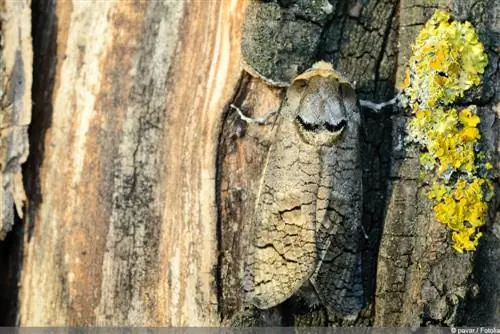
Fighting the willow borer is not easy. The caterpillars that cause the damage hide inside the tree, where they are difficult to reach. Only in their early stages are they close to the surface and therefore easier to access. Unfortunately, there are few resources available to combat it. It is not always certain that the tree will actually be saved. Spreading to nearby trees is possible at any time, which increases the pressure to succeed. Emergency felling is often the only way to limit the impact of the red caterpillars.
Quassia broth
Quassia wood is a very special kind of bitterwood. The active ingredient quassin it contains is fatal to numerous types of vermin, including the eggs and newly hatched larvae of the willow borer. To extract quassin from the bitterwood, a broth must be prepared. You can easily make this natural pesticide yourself.
- You need 150 grams of bitterwood. Pour 2 liters of water over it and leave it like that for a day.
- Boil the solution vigorously for one hour.
- Sift out the wood chips and let them dry. They can be reused up to three times.
- Before using, dilute the broth with 10 liters of water.
- Spray the tree trunk with the quassia broth at regular intervals. After 2-3 days, rinse the covering with clean water. Begin treatment in early spring and continue through fall. The broth can be kept for the entire period.
Tip:
Be cautious when using quassia broth. Only spray locally. It is not only poisonous to the willow borer, but also to many beneficial insects.
Insecticide
The contact poison pyrethrum also works against eggs and newly hatched larvae of the willow borer. Various types of chrysathmas are the starting point for the production of insecticides with this active ingredient. There are several preparations available on the commercial market, each with different names. The poison damages the nerve cells of the willow borer and other insects. It doesn't matter whether it is a pest or a beneficial organism. That's why this insecticide should also be used sparingly.
Parasitic wasps
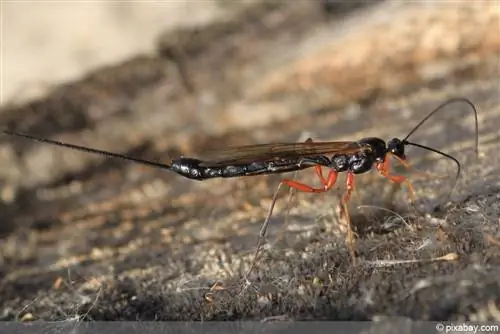
Parasitic wasps are tiny insects that should not be confused with the large, dreaded wasps. They have been used successfully against food and clothes moths for years. However, parasitic wasps are not only specialized in these two species. This makes them interesting for combating other butterflies.
- are very small, about 0.4 mm
- don't fly, they crawl
- feed on eggs and caterpillars
- are completely harmless to humans
- also for other animals and plants
- Once they have eaten their food, they disappear from the scene
- die and turn to dust
- Cards with parasitic wasps can be purchased online
Killing caterpillars
Caterpillars that have already penetrated deep into the interior of the tree are hardly reached by the measures mentioned above. That's precisely why it's extremely important not to let it get to that point. However, if the infestation is discovered late, there is no choice but to leave the tree to the caterpillars or try an extremely harsh method. A sturdy wire is used to pierce the holes that are visible from the outside. The large caterpillars are pierced by the wire and killed. This is not for sensitive souls. Unfortunately, not all caterpillars will be caught this way, but their number will certainly be significantly reduced.
Cut away affected parts
If the entire tree is severely affected, it must be felled and the rootstock dug up. However, if only part of the branches are affected by the willow borer, generously cutting away the affected areas can be a viable option.
- cut into the he althy wood
- the month of May is the ideal time
- Seal cuts with appropriate protective products
Tip:
Regardless of whether the whole tree or just parts are felled, the professional disposal of the wood waste must always be ensured. Otherwise, the caterpillars also survive in dead wood and soon attack other trees. The most effective method of destruction is burning.
Conclusion
Willow borers are a deadly threat to our apple and pear trees. Especially when the caterpillars remain undetected and hollow out the trunks undisturbed for years. An attentive fruit tree owner who knows the signs and starts the fight early has a good chance of driving away the caterpillars and harvesting from his fruit trees for a long time to come.

